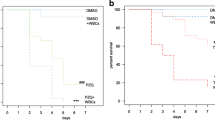Abstract
The tegumental changes in adult Opisthorchis viverrini induced by tribendimidine were analyzed by scanning electron microscopy (SEM). We exposed O. viverrini to tribendimidine at a concentration of 10 μg/ml for 4 h. In addition, hamsters were treated with a single 400 mg/kg oral dose of tribendimidine and flukes were recovered from the bile ducts 24, 48, 72, and 96 h post-treatment. SEM analysis of the flukes incubated in vitro showed only mild damage of the tegument. Twenty-four hours post-treatment of hamsters, extensive disruption such as sloughing, furrowing, or blebbing of the tegument was evident, which did not increase in severity 48–72 h post-treatment. Ninety-six hours after tribendimidine administration, the majority of flukes had been expelled. A single 400 mg/kg oral dose of tribendimidine administered to O. viverrini-infected hamsters yielded a worm burden reduction of 63.0%. In conclusion, our experiments confirm that tribendimidine possesses interesting trematocidal properties, which warrant additional investigations and provide further data for subsequent clinical trials.



Similar content being viewed by others
References
Apinhasmit W, Sobhon P (1996) Opisthorchis viverrini: effect of praziquantel on the adult tegument. Southeast Asian J Trop Med Public Health 27:304–311
Becker B, Mehlhorn H, Andrews P, Thomas H (1981) Ultrastructural investigations on the effect of praziquantel on the tegument of five species of cestodes. Z Parasitenkd 64:257–269
Haswell-Elkins M, Levri E (2003) Food-borne trematodes. In: Cook GC, Zumla AL (eds) Manson’s tropical diseases, 21st edn. Saunders, London, pp. 1471–1486
Keiser J, Utzinger J (2007a) Advances in the discovery and development of novel trematocidal drugs. Exp Opin Drug Discov 2(Suppl 1):S9–S23
Keiser J, Utzinger J (2007b) Food-borne trematodiasis: current chemotherapy and advances with artemisinins and synthetic trioxolanes. Trends Parasitol 23:555–562
Keiser J, Morson G (2008) Fasciola hepatica: tegumental alterations in adult flukes following in vitro and in vivo administration of artesunate and artemether. Exp Parasitol 118:228–237
Keiser J, Xiao SH, Jian X, Chang ZS, Odermatt P, Tesana S, Tanner M, Utzinger J (2006a) Effect of artesunate and artemether against Clonorchis sinensis and Opisthorchis viverrini in rodent models. Int J Antimicrob Agents 28:370–373
Keiser J, Xiao SH, Tanner M, Utzinger J (2006b) Artesunate and artemether are effective fasciolicides in the rat model and in vitro. J Antimicrob Chemother 57:1139–1145
Keiser J, Xiao SH, Utzinger J (2006c) Effect of tribendimidine on adult Echinostoma caproni harbored in mice, including scanning electron microscopic observations. J Parasitol 92:858–862
Keiser J, Thiemann K, Endriss Y, Utzinger J (2008) Strongyloides ratti: in vitro and in vivo activity of tribendimidine. PLoS Negl Trop Dis 2:e136
Mehlhorn H, Kojima S, Rim HJ, Ruenwongsa P, Andrews P, Thomas H, Bunnag B (1983) Ultrastructural investigations on the effects of praziquantel on human trematodes from Asia: Clonorchis sinensis, Metagonimus yokogawai, Opisthorchis viverrini, Paragonimus westermani and Schistosoma japonicum. Arzneimittelforschung 33:91–98
Nwaka S, Hudson A (2006) Innovative lead discovery strategies for tropical diseases. Nat Rev Drug Discov 5:941–955
Ren HN, Cheng BZ, Zhuang ZN (1987) Experimental therapeutic efficacy of a new anti-hookworm drug-tribendimidine. Chin J Parasitol Parasit Dis 5:262–264 (in Chinese)
Sirisinha S, Puengtomwatanakul S, Sobhon P, Saitongdee P, Wongpayabal P, Mitranonde V, Radomyos P, Bunnag D, Harinasuta T (1984) Alterations of the surface tegument of Opisthorchis viverrini exposed to praziquantel in vitro and in vivo. Southeast Asian J Trop Med Public Health 15:95–103
Sobhon P, Wanichanond C, Saitongdee P, Koonchornboon T, Bubphaniroj P, Upatham ES, Puengtomwatanakul S, Sirisinha S (1986) Scanning electron microscopic study of Opisthorchis viverrini tegument and its alterations induced by amoscanate. Int J Parasitol 16:19–26
Sripa B (2003) Pathobiology of opisthorchiasis: an update. Acta Trop 88:209–220
Xiao SH, Wu HM, Tanner M, Utzinger J, Wang C (2005) Tribendimidine: a promising, safe and broad-spectrum anthelminthic agent from China. Acta Trop 94:1–14
Acknowledgments
We thank Mr. Gianni Morson at the Centre for Microscopy, University of Basel for expert help with the SEM studies. J. Keiser (project no. PPOOA-114941), J. Utzinger (project no. PPOOB-102883) and P. Odermatt (project no. NF3270B0-110020) are grateful to the Swiss National Science Foundation for financial support.
Author information
Authors and Affiliations
Corresponding author
Rights and permissions
About this article
Cite this article
Keiser, J., Utzinger, J., Xiao, SH. et al. Opisthorchis viverrini: efficacy and tegumental alterations following administration of tribendimidine in vivo and in vitro. Parasitol Res 102, 771–776 (2008). https://doi.org/10.1007/s00436-007-0838-7
Received:
Accepted:
Published:
Issue Date:
DOI: https://doi.org/10.1007/s00436-007-0838-7




